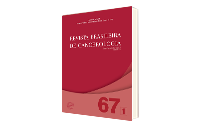Association Between Bacterial Vaginosis and Cytological Abnormalities in Cytopathological Exams Analyzed in a Laboratory School of Goiânia-GO
DOI:
https://doi.org/10.32635/2176-9745.RBC.2021v67n1.1080Keywords:
Papanicolaou Test, Gardnerella vaginalis, Vaginosis, Bacterial, Vaginal Smears, PathologyAbstract
Introduction: Gardnerella vaginalis facilitates human papillomavirus (HPV) infection. Objective: To verify the association between cytological abnormalities and the presence of Gardnerella vaginalis in cervicovaginal smears sent to the Clinical Laboratory of the Pontifical Catholic University of Goiás (LAC/PUC Goiás) stratified by age range. Method: Cross-sectional study carried out at LAC/PUC Goiás from January 2013 to December 2015. For statistical analysis, the variable age was categorized as ≤39 years and >40 years, using the IBM SPSS Statistics program (Version 2.0, 2011®) for the chi-square test (X²), with a 95% confidence interval and p<0.05. Results: 4,558 cytopathological exams were analyzed, most of them with the presence of Lactobacillus spp (46.97%). The prevalence of pathogens was Gardnerella vaginalis (79.6%), followed by Candida spp. (16.8%), Trichomonas vaginalis (2.2%), Herpes simplex (0.4%) and Chlamydia trachomatis (0.1%). Cytological abnormalities were observed in 9.1%, being atypical squamous cells of undetermined significance (ASC-US) 2.57%, low grade squamous intraepithelial lesion (LSIL) 1.78%, atypical squamous cells of undetermined significance cannot exclude high intraepithelial lesion (ASC-H) 3.52%, high grade squamous intraepithelial lesion (HSIL) 1.08%, atypical endocervical cells, neoplastic favor (AGC-NEO) 0.22% and carcinoma 0.02%. There was a significant association between severe cytological abnormalities and women >40 years old OR 3.01 (95% CI 2.0-4.58) (p<0.0001). Women ≤40 years old showed the presence of Gardnerella vaginalis (p<0.0004). Conclusion: A high prevalence of Gardnerella vaginalis was found and its association with cytological abnormalities, especially in sexually active women.









